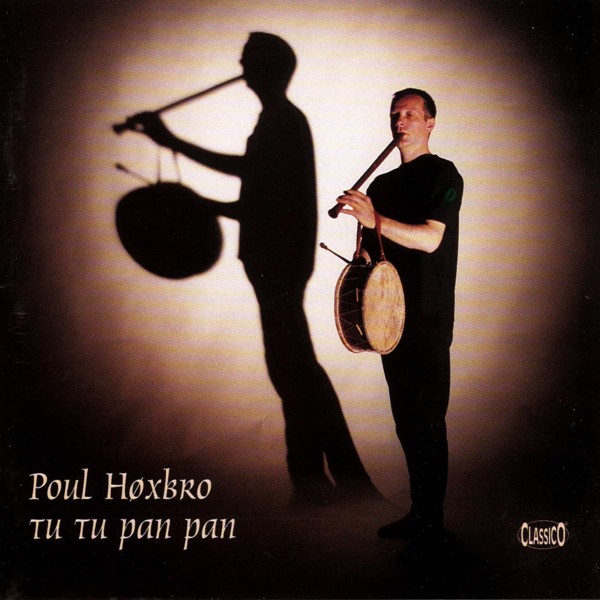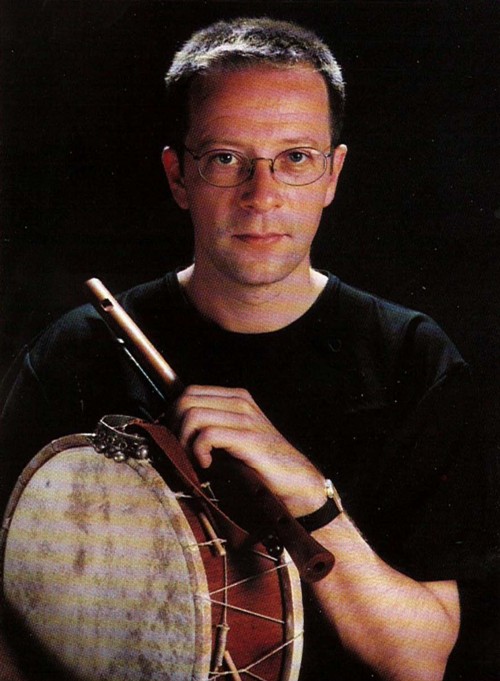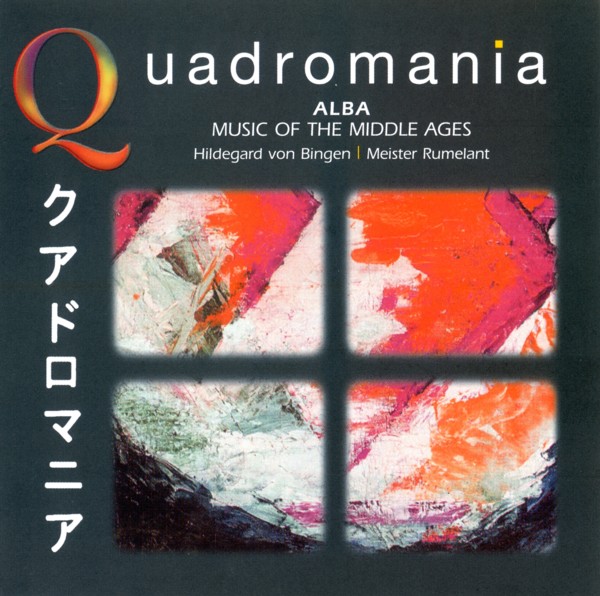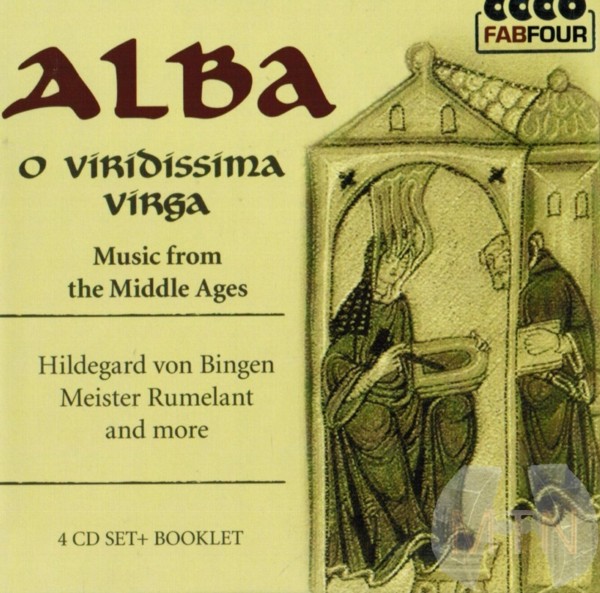
medieval.org
Classico CLASSCD 286
1999

medieval.org
Classico CLASSCD 286
1999
1. Got in vier elementen [2:42]
Meister RUMELANT, Germany 13th century
2. Salterello [5:03] anon. Italy, c. 1400
3. La tierche estampie royal [3:15] Anon. France, c. 1300
4. Christo e nato e humanato [3:47]
From the "Laudario de Cortona", Italy 13th century
Melodic material from the "Cantigas de Santa Maria", Spain 13th century
5. Sabor a Santa Maria [2:53]
CSM 328 +
CSM ? ·
CSM ?
6. Santa Maria loei [4:03]
CSM 200 +
CSM 166 ·
CSM 9
Two ballatas by GHERARDELLUS, Italy c. 1363
7. De' poni amor a me [2:35]
8. I vo bene a chi vol bene a me [2:08]
9. Danse [2:32] anon. France c. 1300
10. From 'Danger me hath, unskylfuly' [3:06] England 13th c.
Untitled instrumental piece from England (Coventry ?) 13th century
11. Douce 139 [1:44]
HILDEGARD von BINGEN, Germany 1098-1179
12. Unde quocumque [4:14]
13. O Euchari [3:45]
Melody from a song of praise to the Danish King Erik Menved by
Meister RUMELANT, Germany 13th century
14. Got in vil hohen vreuden saz [5:02]
Material from melodies collected in the 19th century to the Danish medieval ballad about the talking harp. (DgF 95)
15. Den talende strengeleg [2:39]
A
set of folk tunes from Denmark and the Faroe Islands to the songs
Skon Redselil og hendes moder, Ramun, Det var bolde Hr. Nilaus)
16. Folktunes [4:12]
Poul Høxbro
pipe and tabor, pipe and string drum, double pipes
All instrumental renditions and arrangements by Poul Høxbro
Recording: Audiophon Recording Studio, 1999

"...Guy with drum and pipe plays for them this estampie..."
This
line is from a song by the trouvère Jehan Erars (c. 1200 -1259), and it
is one of the first references in existence to the instruments pipe and
tabor being played by one and the same person. The first actual
illustration is found in the El Escorial manuscript of the Spanish king Alfonso the Wise's large collection of Marian songs Cantigas de Santa Maria
from about 1260. When the instrumental combination was conceived
remains uncertain for the time being, but what is certain is that the
combination flourished in the 13th, 14th and 15th centuries, when it was
prevalent on the whole of the European continent as a more or less
commonly used musical instrument, if literary references and numerous
illustrations are to be considered significant. Of course it can always
be maintained that both words and pictures have been created according
to literary or iconographic models, but if one disregards this rigid
view of historical sources, a completely different picture of the
instrumental combination pipe and tabor emerges from that suggested by
reading books and articles on mediaeval music.
It is quite clear
that there was never any question of the instruments being a musical
curiosity in the Middle Ages. Neither was there any tendency to limit
the use of them to specific musical situations or any unequivocal
association with the Devil - or God for that matter. It is true that the
few Nordic pipe and tabor players we can see illustrated today wear a
fool's costume, and indeed there are many situations involving dancing
which are connected with the instruments, but otherwise the pipe and
tabor crop up quite simply on the same footing as other common
instruments of that time, from the great, symbolic orchestras of angels
to illustrations of everyday music-making, when their function seems to
have been unusually versatile. On the street level it can be seen as an
accompaniment to bear-tamers, acrobats and the chain dances so deplored
by the clergy. At the other end of the scale the pipe and tabor appear
in church processions, at royal wedding ceremonies as well as generally
in small ensembles of angels, when it was often used together with the
harp and rebec.
Between these extremes the instrumental
combination was a common form of entertainment for both high and low,
often as part of a small ensemble of various combinations of the harp,
lute, rebec/fiddle as well as the cornetto. But for the seductive
Moorish dances they were always the only instruments played.
The
pipe and tabor are however also seen in more official situations, for
example as a trio leading an infantry unit or on horseback in a royal
ceremonial procession and providing a background for tournaments and
jousts.
In the Middle Ages it was customary to divide musical
instruments up into two main groups depending on the power of the
instrument in question. The powerful ones like for example trumpets,
horns and shawms were called haut (loud) instruments, and all string instruments, flutes and portatives were called bas
(soft) instruments. The two classes of musical instruments were as a
rule kept clearly apart and did not play in the same ensemble. But here
the pipe and tabor apparently create an interesting exception, since in
the many pictures where they are portrayed they play in one instance
together with the trumpet, shawm and bagpipe, in another with the harp,
lute, psaltery, rebec and fiddle. In the pictures of the large
orchestras of angels or other pictorial allegories in which all
instruments are represented and often divided into the two main groups,
one also sees indications that the pipe and tabor had not achieved a
permanent position in either of the groups, since they seem to have been
classed as loud or soft an equal number of times. In other words it was
an unusually flexible instrumental combination which could be heard in
every conceivable context and perhaps in a far greater part of the
mediaeval tonal conception than former reconstructions of mediaeval
music would seem to suggest.
This was the state of affairs until
the beginning of the 16th century when the pipe and tabor slowly began
to disappear from everyday life and only survived in certain regions.
They are thus specifically mentioned in connection with France, the
Netherlands and England. In the Netherlands they disappeared into
obscurity while in England they were the traditional instruments for Morris Dances
until the beginning of the present century, when the tradition managed
to die out in the space of only a few years, until the instrumental
combination returned to favour in connection with the Morris Dance
tradition. But in the South of France and many places in Spain as well
as in Peru this resourceful oneman-band still plays an important part in
folk music. In the Salamanca province in Spain the pipe and tabor can
still be heard in some churches during the offertory.
And why did this instrumental combination disappear from everyday music-making? In Thoinot Arbeau's dancing treatise Orchesography
from 1589 an explanation almost reminiscent of market economy is
offered, since Arbeau says that in his father's time it was customary to
cut down on expenses by hiring only one musician who played two
instruments at once, while at the present time the lowliest workman
would have both oboes and trombones playing at his wedding. This is
hardly the whole truth and probably not the most important reason. A
more likely explanation is to be found in the relationship between the
specific limitations of the flute played with one hand seen in
connection with modifications of the then prevalent musical language. As
long as music exclusively moved within a modal universe with simple
chromatic adjustments determined by the so-called rules of musica-ficta,
the flute could cope with most demands made upon it, but it failed when
further demands for greater flexibility were made upon it. Neither had
the tendency to increase the range required in written compositions
encouraged the use of the flute, since it was extremely uneven in the
uppermost register. Indeed it was not able to keep up with developments
in art-music, and in this way it was compelled to retire from the scene
and continue an obscure existence as an instrument of the people, so
that in general it had been supplanted by other, more popular
instruments.
The pipe, or flute played with one hand, is a type
of recorder / flageolet with three finger holes. A narrow inner bore
ensures that it is easy to play notes in the harmonic series by
overblowing. In the first octave it is only possible to produce the
first four notes before overblowing to the second octave, but from here
the three holes are sufficient to make it possible to fill out the
intervals between the notes which are overblown and in this way play a
full scale with a compass of at least one and-a-half octaves. There seem
to have been three basic sizes, the middle one tending to be the
favourite, although in the Middle Ages there were probably no actual
standard sizes. However, judging from the dimensions in the vast
majority of pictures, the most common pipe seems to have had a
fundamental somewhere between a and f. In several of the
earliest pictures there is also a pipe which seems to be smaller than
this, whereas especially towards the end of the period in which the pipe
flourished, the upper classes appear to have preferred a somewhat
larger pipe, probably with a fundamental between e and c.
Apart
from this pipe played with one hand the standard version of the
"ensemble" also comprised a tabor. The tabor had parchment on both sides
which was secured by string, making it possible to regulate the
tautness of the skin. In the great majority of cases strings were
stretched over one of the skins, giving a rattling effect each time the
drum was struck. Until well into the 15th century the tabor was always
flat, the diameter (8 - 14 inches?) being greater than the depth, but in
the course of the 15th century and later, there was more often a
tendency to make the tabor deeper than the diameter. And not until the
very latest pictures from the 16th, 17th and 18th centuries does the
tabor now and then assume the dimensions which are known from the
Provençal tambourin or the tamboril of Salamanca.
So this is the
standard version of the popular one-man-band. But there were also
exceptions which in the most beautiful possible way justify the modern
musician's desire for experimentation with sounds. In a tapestry from
about 1510 in Musée Royaux et d'Histoire in Brussels an
aristocratic trio consisting of a singer, a clavichord and a large
one-handed pipe is woven into the portrayal. In Palazzo Publico in Sienna, Taddeo di Bartolo (1362-1422) has painted an angel with pipe and triangle, and in Estuna Church,
Sweden, a musician can be seen holding a pipe in one hand and two bones
in the other in exactly the same way as musicians playing Irish
folk-music still do today. With regard to living musical traditions it
is in this connection interesting to turn one's attention to Gascogne
and Beam in France as well as to Aragon in Spain, where the tabor is
replaced by a drum with strings. This instrument is an ordinary
box-zither, i.e. a resonating box with strings tuned in fifths
corresponding to the tonality of the pipe played with one hand, and it
is beaten by the same musician with a stick in accompanying rhythmical
patterns in the same way as with a drum. Such an instrument was also
known in the Middle Ages under names including Chorus and is
seen illustrated in several places in connection with singing. As far as
I know there are no mediaeval pictures of the pipe and string drum, but
on the basis of well-known traditions and pictures of the pipe and
triangle and pipe and bones it seems highly unlikely that no attempts
were made to exploit this combination in the Middle Ages, if only to a
limited extent, since there is no iconographic or literary evidence to
support this claim.
Yet another mediaeval instrumental
combination with the pipe played with one hand can be mentioned here,
namely the double pipe (double flageolet), which means two pipes
played by the same person. This instrument was also of common occurrence
in certain regions. Howard Mayer Brown has for example established that
it was frequently to be found in 14th century Italy. It can often be
difficult to see which flutes, or perhaps reed instruments, are in
question. In some pictures it would seem that there are merely two small
recorders with the small range made possible by the few holes, but in
other cases there are clearly two pipes of the kind which are played by
one hand. The double flageolets are also most often illustrated
at a time and in such a way that makes it difficult to determine their
scale in relation to each other because of the lack of perspective in
the pictures, but from those which are clearest it would seem that in
most cases the flutes were the same size and with the mouths in the same
place, which would give the same tuning, and only exceptionally did the
pipes' proportions differ. Exactly which function these double flageolets
had is in many ways far more puzzling than that of the pipe and tabor,
whose built-in logic of melody and rhythm in combination with living,
accessible musical traditions to a great extent points forwards (or
backwards). But however clear or obscure an early practice may appear
today, historical fact will always support any argument that creative
experimentation, curiosity and the wish or demand that innovation at
whatever time in western history has been the driving force, also in
everyday music-making.
This of course also applies today, when one looks back in a forward-moving perspective.
Poul Høxbro, Copenhagen 1999
English translation: Gwyn Hodgson
Compilations:

